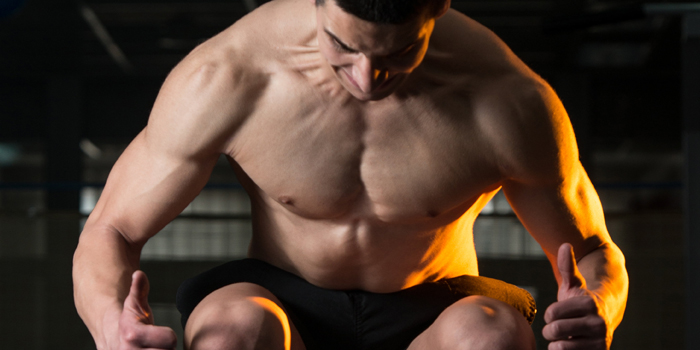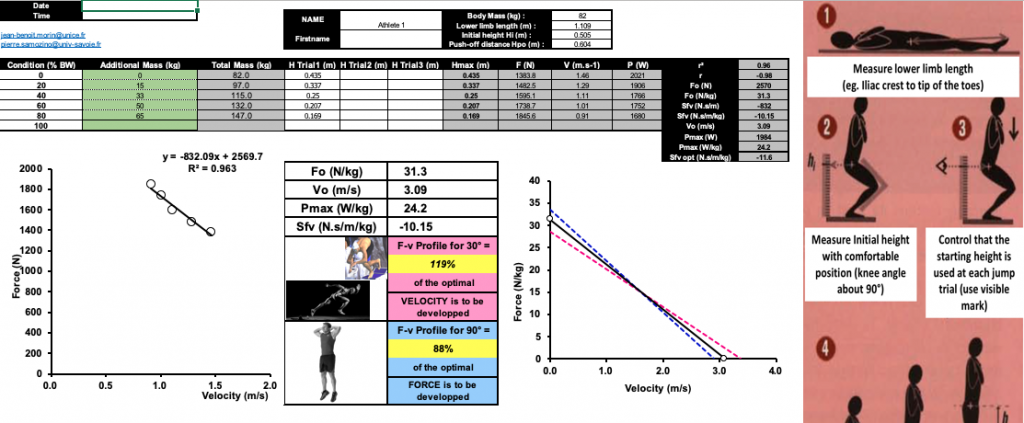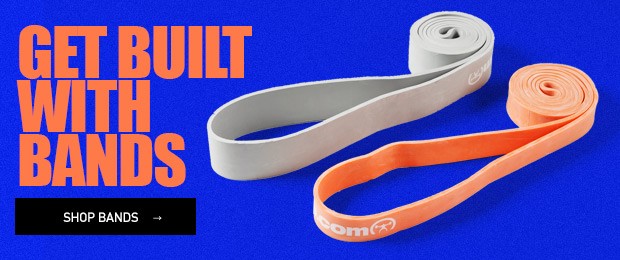
One of the key questions that any strength and conditioning coach should ask before writing a new program is: “How will this program benefit the athlete on the field of play?”
Obviously, there is more to it than this. The needs of the sport are a paramount consideration and the athletes’ physical history (including training history, injury history, etc.).
During my (now not so) recent postgraduate studies, I was exposed to a lot of research into and application of vertical force-velocity (Fv) profiling. Something about it just clicked for me. This article will focus specifically on the theory and practical application of vertical Fv profiling and how it can individualize program design.
Vertical Force-Velocity Profiling
An individuals’ Fv profile is calculated from the force- and power-velocity relationships, which characterize the maximum mechanical capabilities of the lower-limb neuromuscular system (Morin & Samozino, 2016). It has been demonstrated theoretically (Samozino, et al., 2012; 2008) and confirmed experimentally (Samozino, et al., 2014) that an optimal Fv profile exists for each individual, which:
- Corresponds to maximal lower limb ballistic performance (e.g. vertical jumping).
- Represents the optimal balance between force and velocity qualities (Jimenez-Reyes, et al., 2014; Samozino, et al., 2012; 2008).
The relative difference between an individuals’ actual and optimal Fv profiles (i.e., their current performance vs. theoretical potential) represents the size and direction of the unfavorable balance between force and velocity qualities. This is termed the force-velocity imbalance (Fvimb, expressed as a %) and subsequently allows a coach to classify an individual as having either a force (below the optimal) or velocity (above the optimal) deficit.
MORE: Understanding the Force-Time Curve’s Role in Breaking PRs
Implementation of Vertical Force-Velocity Profiling
I have personally implemented vertical Fv profiling into my own practice because, for a given maximal power (Pmax), vertical jump performance has been shown to be negatively correlated to Fvimb. In other words: the greater the imbalance (or further from the optimal), the worse the performance. This suggests that an individuals’ Fvimb should be considered when designing training programs to improve ballistic performances (Samozino, et al., 2014; 2008).
How will this program benefit the athlete on the field of play?
Practically, individual Fv profiles and Pmax can be accurately determined in the field using a series of two to six loaded vertical jumps (Janicijevic, et al., 2019; Jiménez-Reyes, et al., 2017; Samozino, et al., 2008), whilst the optimal Fv profile can be computed using equations proposed by Samozino et al., (2012; 2008). A spreadsheet constructed by J.B. Morin and Pierre Samozino is freely available online and can be easily implemented into strength and conditioning practice. Its use is very simple. The coach only needs to input the athletes’ body mass (kgs), lower-limb length (m), and initial jump height (m)—the spreadsheet does the rest.
Personally, I like to utilize a squat jump with a start position where the knee is flexed to 90°. From my perspective, it’s easier to regulate and consistently apply it across groups. Recent research, however, has proposed that a self-selected depth may be more beneficial as it represents actual sporting performance more (Janicijevic, et al., 2019). This is certainly worth considering. Exactly how often does an athlete have time to measure their knee angle during competition?
It could be argued that when the jump height is self-selected, the variability of the jump height increases (i.e., there is no consistency), which affects the calculations of mean force, velocity, and power (values which are important for overall profile calculation). However, comparable reliability was demonstrated in all Fv metrics between a fixed 90° and self-selected depth methods, provided push-off distance was unchanged in calculations, so this is no major cause for concern.
Resultantly, a self-selected starting depth might be something I consider in my future practice, but I’m unsure at present.
Regarding the number of loads used, I have utilized a five-load approach where the additional loads correspond to 0, 20, 40, 60, and 80% body mass. For example, I worked with a 100kg academy rugby player who resultantly performed jumps with; no additional load; 20kg; 40kg; 60kg; and 80kg. This has worked really well for me, as it gives a good insight into where the athletes’ strengths and weaknesses lie.
On the flip side, I do consider that there might be a fatigue effect in play during the higher load jumps. By the time the athlete reaches the final loading condition, they’ve already performed twelve jumps, nine of which were under additional load. It has been proposed that a two-load approach is perfectly acceptable due to the linear nature of the Fv relationship (Jaric, 2016). Again, this is something I will definitely consider implementing for the reasons mentioned above, and it would almost certainly speed up implementation within groups.
Once the jump profile has been completed and the data inputted into the spreadsheet (I have included some example data below), the coach is presented with a number that refers to Fvimb (there are actually two numbers, but we are only concerned with the one titled Fv profile for 90°). As discussed previously, the key here is to try to get this number as close to optimal as possible, i.e. 100%. As discussed, if an athlete presents an Fv profile of <100%, then they are displaying a force deficiency. Conversely, an Fv profile of >100% indicates a velocity deficiency. Resultantly, the coach now has an idea of how to structure an athletes’ training program in order to address this Fvimb; force deficient subjects need to get stronger whilst velocity deficient subjects need to get faster. Remember, however, everything discussed here refers to vertical jumping, so “speed” in this context does not refer to horizontal displacement (i.e. running). If and when the optimal profile is achieved (i.e. Fv profile of 100%), for a given Pmax the athlete should display their maximal jumping performance.

Depending on how big the deficiency is, the ratio of different training types can be emphasized as necessary; Jimenez-Reyes, et al., (2017) defined the ratios in the table below. High-level deficits obviously require a greater degree of focus on the respective weakness, whereas low deficits should still emphasize these but can encompass a broader range of training modalities. Athletes who present a more balanced Fv profile essentially just need a little bit of polish: their focus should still be on reducing Fvimb, but should mainly focus on increasing their Pmax as this will lead to greater jumping performances.
Bringing this back to the start, our objective was to help the athlete progress on the pitch. Although this is one of the many ways we can do this, completing an Fv profile and then working to reduce Fvimb will allow us to address an athletes’ specific weaknesses and put them in a position to produce greater outputs from their neuromuscular systems. To throw a spanner in the works, I’m not saying that improving an athletes’ Fv profile will immediately make them a better athlete on the field. There is obviously much more to the process than improving some numbers that get kicked out of a spreadsheet.
| F-Vimb Categories | Threshold Values for F-vimb (%) |
| High Force Deficient | <60 |
| Low Force Deficient | 60-90 |
| Well Balanced | 90-110 |
| Low Velocity Deficient | 110-140 |
| High Velocity Deficient | >140 |
Summary
To summarise, hopefully, I have presented a good overview of what vertical Fv profiling is and a rationale as to why I have utilized it within my practice. I welcome comments from other coaches to share thoughts and ideas concerning; force-velocity profiling; its place within athletic development; and how the process can be streamlined and improved so that we can all benefit.
I’d also like to acknowledge that none of the science involved here is my own work, it is merely the interpretation and practice of research conducted by people much, much smarter than myself. I am sure I also make errors along the way, but I do hope I get more things right than wrong.
I strongly encourage anyone who is interested in learning more to dive into the research papers I have listed as references and any work produced by JB Morin; Pierre Samozino; Pedro Jimenez-Reyes and their research groups.
Thank you for your time reading this article. I hope you have gained something from it.
References
- Barnes, C., Archer, D. T., Hogg, B., Bush, M., & Bradley, P. S. (2014). The evolution of physical and technical performance parameters in the English Premier League. International Journal of Sports Medicine, 35(13), 1095-1100.
- Cormie, P., McGuigan, M. R., & Newton, R. U. (2010). Adaptations in Athletic Performance after Ballistic Power versus Strength Training. Medicine and science in sport and exercise, 42(8), 1582–1598.
- Fernandes, J. F., Daniels, M., Myler, L., & Twist, C. (2019). influence of playing standard on upper- and lower-body strength, power and velocity characteristics of elitle rugby league players. Journal of functional morphology and kinesiology, 4(22), doi: 10.3390/jfmk4020022.
- Janicijevic, D., Knezevic, O., Mirkov, D., Pérez-Castilla, A., Petrovic, M., Samozino, P., & Garcia-Ramos, A. (2019). Assessment of the force-velocity relationship during vertical jumps: influence of the starting position, analysis procedures and number of loads. European Journal of Sport Science, DOI: 10.1080/17461391.2019.1645886.
- Jaric, S. (2016). Two-load method for distinguishing between muscle force, velocity, and power-producing capacities. Sports Medicine, 46(11), 1585–1589.
- Jimenez-Reyes, P., Samozino, P., & Morin, J.-B. (2019). Optimising training for jumoing performance using the foce-velocity imbalance: Individual adaptation kinetics. PLOS One, 14(5), DOI: e0216681.
- Jimenez-Reyes, P., Samozino, P., Brughelli, M., & Morin, J.-B. (2017). Effectiveness of an individualised training based on force-velocity profiling during jumping. Frontiers in physiology, 7(677), doi: 10.3389/fphys.2016.00677.
- Jiménez-Reyes, P., Samozino, P., Cuadrado-Peñafiel, V., Conceição, F., González-Badillo, J. J., & Morin, J. B. (2014). Effect of countermovement on power-force-velocity profile. European Journal of Applied Physiology, 114(11), 2281-2288.
- Jimenez-Reyes, P., Samozino, P., Garcia-Ramos, A., Cuadrado-Penafiel, V., Brughelli, M., & Morin, J.-B. (2018). Relationship between vertical and horizontal force-velocity-power profiles in various sports and levels of practice. PeerJ, 6(e5937), DOI 10.7717/peerj.5937.
- Jiménez-Reyes, P., Samozino, P., García-Ramos, A., Cuadrado-Peñafiel, V., Brughelli, M., & Morin, J.-B. (2018). Relationship between vertical and horizontal force-velocity-power profiles in various sports and levels of practice. PeerJ, 6(e5937), DOI 10.7717/peerj.5937.
- Jiménez-Reyes, P., Samozino, P., Pareja-Blanco, F., Conceição, F., Cuadrado-Peñafiel, V., González-Badillo, J. J., & Morin, J.-B. (2017). Validity of a Simple Method for Measuring Force-Velocity-Power Profile in Countermovement Jump. International Journal of Sports Physiology and Performance, 12(1), 36-43.
- Morin, J.-B., & Samozino, P. (2016). Interpreting power-force-velocity profiles for individualised and specific training. International Journal of Sports Physiology and Performance, 11, 267-272.
- Samozino, P., Edouard, P., Sangnier, S., Brughelli, M., Gimenez, P., & Morin, J.-B. (2014). Force-velocity pofile: Imbalance determination and effect on lower limb ballistic performance. International journal of Sports Medicine, 35(5), 505-510.
- Samozino, P., Morin, J.-B., Hintzy, F., & Belli, A. (2008). A simple method for measuring force, velocity and power output during squat jump. Journal of Biomechanics, 41, 2940-2945.
- Samozino, P., Morin, J.-B., Hintzy, F., & Belli, A. (2010). Jumoing ability: a theoretical integrative approach. Journal of Theoretical Biology, 264, 11-18.
- Samozino, P., Rabita, G., Dorel, S., Slawinski, J., Peyrot, N., Saez de Villarreal, E., & Morin, J.-B. (2016). A simple method for measuring power, force, velocity properties, and mechanical effectiveness in sprint running. Scandinavian journal of sports science, 26(6), 648-58.
- Samozino, P., Rejc, E., Di Prampero, P. E., Belli, A., & Morin, J.-B. (2012). Optimal Force–Velocity Profile in Ballistic Movements—Altius: Citius or Fortius? Medicine and Scoence in Sport and Exercise, 44(2), 313–322.
Tom Bryan is a strength and conditioning coach. He works at Hartpury College and University, UK. Tom started as an intern at London Scottish FC, followed by a number of both academy and senior jobs at various rugby clubs. A move to Hartpury College followed where Tom completed his MSc in Applied Strength and Conditioning and worked with the men’s rugby program, before taking up a role with the women’s team and then moving into his current role where he works with the Hartpury netball, soccer, golf, and multi-sport academies.










